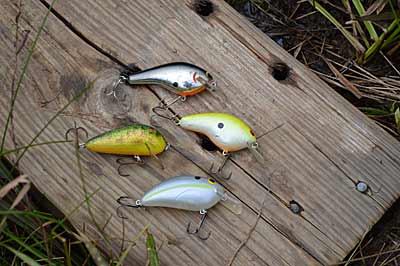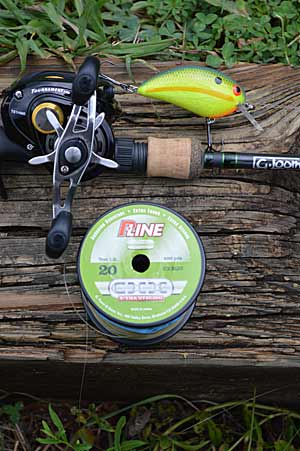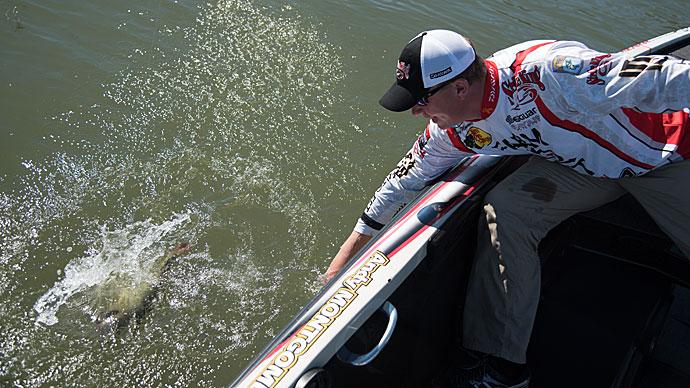
You have to make them bite before you can catch them.
Putting that time-tested saying into practice takes an extra shot of confidence when you’re staring at shallow water filled with aquatic vegetation and a crankbait dangling from your line. Treble hooks and grass can be frustrating, fouling presentations and robbing precious fishing time as you clean your lure. But there is a good reason to mix the two: more and bigger bass.
It’s no secret that bass will spend their time swimming in stretches of aquatic vegetation when they have that option. Regardless of emergent fields, submerged beds, or isolated patches, largemouth, and smallmouth can be found in all of them. Weedless lures, such as spinnerbaits, vibrating jigs, frogs, and Texas-rigged soft plastics, are the usual choices for fishing in these situations. But you should try crankbaits, too.
Crankbaits offer several benefits for fishing aquatic vegetation. They can be fished fast, allowing you to cover vast amounts of water in a little amount of time. Their action and rattles draw reaction strikes from sullen bass that watch slower presentations swim by. And available in myriad shapes and bill designs, a perfect one can be found for any situation, regardless of depth or amount of cover.
Where you present crankbaits around shallow aquatic vegetation is straightforward. The most common opportunity comes with large beds within a foot or two of the water’s surface. Outside spawning flats or shoreline cover that summer’s lower water level has made unusable, bass use thicker patches and open spaces within these beds to ambush baitfish and crawfish. Here you’ll want your crankbait to skim over the vegetation, occasionally catching in. Tipping it free creates reaction strikes.
Isolated patches of aquatic vegetation, such as milfoil or coontail, is the next place to throw a crankbait. These are often scattered across rocky or sandy flats near the main lake or river channel. Here you’ll want a crankbait that dives slightly deeper, getting down to the base of the plants. Instead of a fan-casting approach, as you would attack the beds mentioned above, proper casting angles are crucial. Your crankbait should wobble across points, edges, and clumps, where bass, especially smallmouth, are ready to pounce.
Emergent or matted aquatic vegetation is the least likely place to throw a crankbait. Other than the outside or inside edge, there aren’t any lanes open enough to line up a retrieve. The exception may be a field of sparse lily pads, where you can get a crankbait down and around their stems.
Small bills and big bodies
Crankbaits that fish best around wood and rock aren’t the best at tackling shallow aquatic vegetation. Instead of bouncing off a piece of cover or structure, crankbaits are retrieved over and around vegetation, whether a submerged bed or scattered clumps.

Other than the lipless variety, crankbaits use bills to create action. Long or short, rounded or square, plastic or computer board comes in many styles. Shorter bills, for example, are the hallmark of shallow-diving crankbaits. And they’re available in two shapes: rounded and square. While both work around aquatic vegetation, each has its action.
Rounded bills create a broad and lumbering action, which works well in warmer water temperatures and helps crankbaits navigate hard cover, such as rocks and wood. Square bills create an erratic and throbbing wobble. Instead of rolling around the cover, these crankbaits pound their way over or through it.
While length is important, the bill’s angle must also be considered. The closer it is to perpendicular to its body, the shallower the crankbait will dive. Wake baits, a type of crankbait that barely breaks the surface, sport a 90-degree bill. At the other end of the spectrum, deep-diving crankbaits have bills that run nearly straight in front of their body.
Crankbaits best suited for fishing around shallow aquatic vegetations have a short bill and a rounded body, which brings an attractive wobble and water resistance, keeping the crankbait running shallower than a thin one. Think of it like a paddle. On edge, it easily cuts through the water. Plunge it flat side first, and considerably more effort is required to reach any depth.
The best-known example of a shallow grass crankbait is the compact Mann’s 1-minus, which has been catching bass for several decades. But they don’t have to be small. Larger ones, such as PH Custom Lures’ Mag Hunter square-bill crankbait, which measures 3 inches in length, displace more water, appealing to big bass hyped up by warm water.
It’s essential to have a selection of crankbaits on hand. That ensures you can reach the desired depth, whether barely ticking the top of a large submerged bed or the roots of isolated patches. And while the shape and bill design will handle most of that work, consider a crankbait’s composition, too. Balsa crankbaits, for example, are more buoyant than plastic ones. That causes them to run slightly shallower and float to the surface quicker when paused during a retrieve, keeping them from becoming mired in vegetation.
Speed down and tip up
When cranking shallow aquatic vegetation, you need to be mindful of retrieve speed and the attitude of your rod’s tip. Both contribute to your crankbait’s diving depth. They’re vital considerations in shallow water, where reaching that perfect point in the water column determines whether you catch bass or snag grass.
Retrieves — whether cranking your reel or sweeping your rod tip — make crankbaits come alive, wiggling and digging. The harder you do either, the deeper your crankbait will dive. So, set your retrieve speed to the depth and amount of aquatic vegetation you are fishing. Move it fast enough to reach the top of the plants, for example, if you are fishing a submerged bed. And crank faster if you’re fishing isolated patches. They grow best in clear water, so a fast retrieve gives bass less time to consider striking. Eat, or it’s gone.
Diving depth also can be controlled by the angle of your rod. The higher you hold its tip, the shallower your crankbait will run.
Right rod and reel
It’s helpful to use a reel packing a gear ratio from 6.3:1 to 7:1, which can easily pick up slack line or slow down a retrieve. But your rod plays a more critical role in successfully cranking shallow aquatic vegetation. So, find the correct mix of length, action, and power.

You’ll want a rod at least 7 feet long, though a 7 1/2-foot model is better. It will allow you to put your rod tip further skyward, helping your crankbait run even shallower. The extra length creates leverage, too, helping pull bass from heavy cover.
Action is how a rod bends through its length while under a load, such as casting a lure or landing a bass. Fast-action rods, for example, only bend at the tip, and slow-action rods bend from tip to handle. While a medium action will work in this situation, you’re better off with a slow-action rod. Its deep bend loads easily, casting lighter crankbaits farther. It also cushions any runs, jumps, or surges that a hooked bass makes, keeping your line tight. A single hook concentrates your force in one point, while a crankbait’s treble hooks spread it over as many as six. With a bit of slack line, that reduction makes it easy for bass to come unhooked.
You also need to decide on the rod’s power, which is how much it will move. Heavy power rods, for example, handle heavier lures and lines than light-action rods. Any power can be matched with any action. And for cranking shallow water vegetation, heavy-power rods with slow action are best.
Bring big line, too
Your line must be tough and strong to pry hooked bass from a tangle of leaves and stems. Avoid fluorocarbon line. While its minimal stretch and durability are positives, they are both erased by its density. That causes it to sink, pulling your crankbait into aquatic vegetation. And while you may be tempted to spool up yards of indestructible modern braided line, old-school monofilament is a better choice.
Monofilament has always been popular for crankbait fishing. Its slight stretch, for example, helps keep the bass hooked. The strength of heavier pound tests — 15 to 20 — matches well with heavy cover, and their relatively large diameter creates plenty of water resistance, stealing more depth from shallow-running crankbaits.
BassResource may receive a portion of revenues if you make a purchase using a link above.




